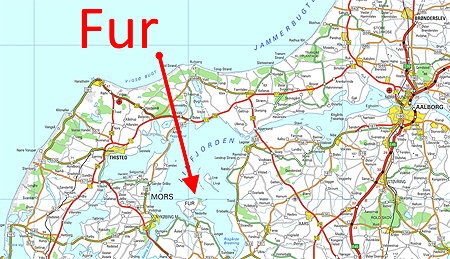
Visiting the island of FurHere you have a short article with photos about mo-clay, vulcanoes, fossils and geology. And surprises for creationists.
We take the little ferry to the island called Fur in the northern part og Jytland, western DK. Here you will see many interesting things.
We will see how the gigantic forces of nature has created this landscape. |
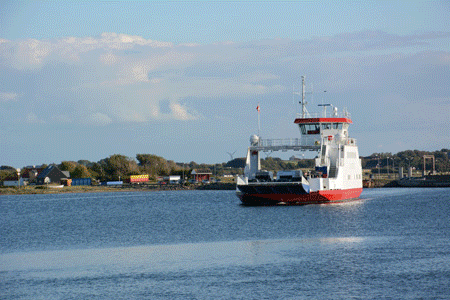 |
|
|
Let us get a map of the fjord called Limfjorden.
The Island of Fur is really small, but it has many surprices, both turists and geologians alike. |
|
|
|
We are on the top of the island. You have a wonderful view full circle around yourself. This island is so beautiful, especially when the sun is shining from the blue sky. No wind, no noise.
The landscape is world class. Here we have a special kind of clay, and it is found only in this part of the fjord, Limfjorden. |
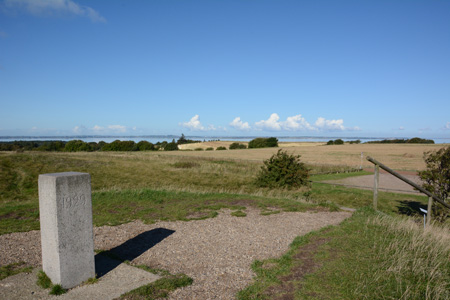 |
|
|
The cliffs on this island and the neighbor island called Mors is so interesting, that UNESCO is trying to get them on the list of heritage.
This cliff is left after many years of mining. Mo-clay is used for refactory stones and cat litter. |
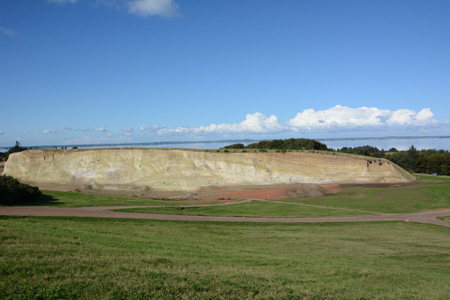 |
|
|
To the east we see the bisp hat. It stands on its own, beautiful and a geological wonder. |
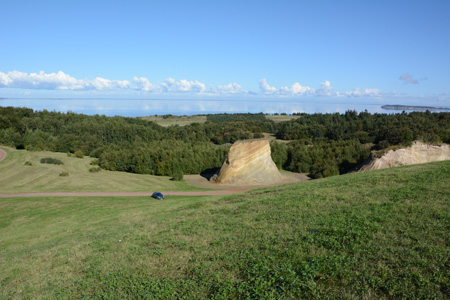 |
|
|
The yellow / brown layers are mo-clay. The dark stribes or layers are from vulcanoes way back in earths history.
The ashes came from vulcanoes in the North See - where we today see Island and the Faroe Islands to day. |
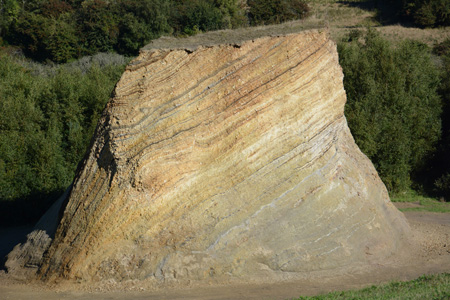 |
|
|
There are 179 layers of vulcanic ashes on Fur. Total thicnes is about 4 meters. Many people have never heard this story before. The vulcanic activity was intense back then. |
 |
|
|
This video clip shows the view from the top of the Island of Fur. A glacier came from the north and punshed up the sea bottom and created these beautiful hills. This is an interesting story of geology. |
||
|
Let us touch the ash layers with our finger and see how you can stratch in it.
The grey ash layer took about one month to be deposited. But the mo-clay above and under was deposited with 4-5 cm per thousand years. That is what general science says.
Here is a problem. The mo-clay contains some fossils that has got to be buried quickly to be preserved. Science tells us that the water was without oxygen, there no decay.
A creationist will not accept this explanation. The layers were doposited quickly in order to give us so many beautiful fossils. |
 |
|
|
Let ud visit the Fur Museum and get some information about the mo-clay and see some fossils. |
 |
|
|
The museum claims that the fossils are 55 million years old.
A creationist is tempted to take away four zeros. The biblical flood is much more closer to 5.500 years than million of years. |
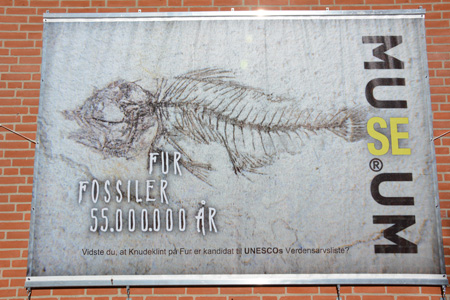 |
|
|
We go inside and look at a discovery made by a German turist some years back. He found the stone to the right down on the beach. Using tools he took it apart and got the top, seen to the left. This is a gigantic fish.
The turist took the top stone with him to Germany and covered the rest of the stone with sand. Later he mailed a postcard to the museum, indicating the location of the stone.
The museum bought the stone from the turist. Therefore the stone is now complete on the display. |
 |
|
|
This mackerel was found recently on Fur. It is well preserved, therefore it was buried quickly.
|
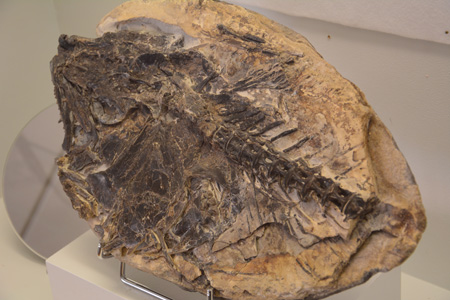 |
|
|
This crab not on display in the museum. The geologist showed it to me and I was allowed to take pictures of it.
Fantastic and well preserved. Again: Buried quickly and not over houndred of years. It would not look like this if it had taken 500 years to cover it up in the mo-clay.
|
 |
|
|
In the geological time called eocene there were may vulcanoes in the North Sea. Around 25 threw ashes up into the air and it was blown to the east over Europe.
In Denmark we find 179 layers of ashes on the islands of Fur and Mors. It is the best place in Europe to find the ashes from the blasts.
The red line is the continental shelf. Greenland is to the top left. Greenland is moving away from Europe. |
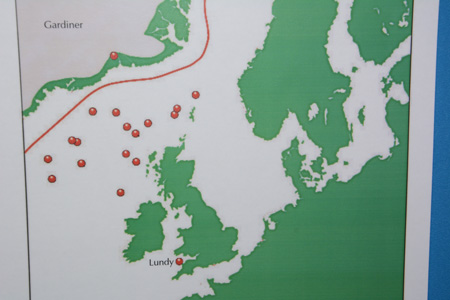 |
|
|
This display shows a part of the history of the island Fur. The mo-clay and the vulcanic layers were deposited over time. During the ice age the bottom of the sea was pushed up and became a hill and the Island of Fur. |
 |
|
|
The ice cap is seen in the top of the picture. It had the function of a buldozer and pushed moraine and the sea bottom towards the south. |
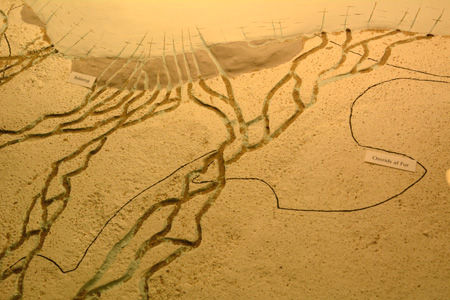 |
|
|
The museum has some wonderful maps of the northern part of Jytland, Denmark.
Note the time settings; we see thousands of years, not millions.
See the sign below: A creationist thinks about the biblical flood, when thís information is given. |
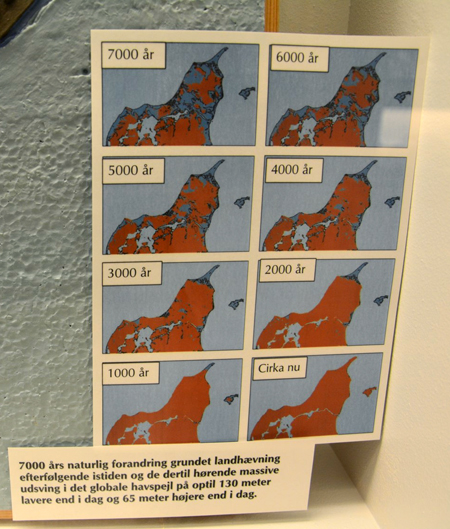 |
|
|
Do you know what coprolite is? It is shit - here fossil feses from a fish.
A fish became scared and a stripe of shit is layed on the sea bottom. The gut was emtied and the fish swam away. |
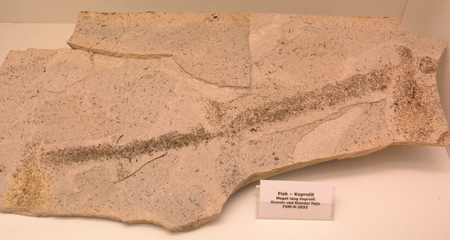 |
|
|
The text under the picture is interesting. We read in Danish: "Vi antager" - that is we assume. We do not know for sure.
Therefore we may also guess. May be the fish got scared when some sediments suddenly came down and touched it. May be a tsunami came about.
Normally geologists talk about an enviroment without oxygen. That explanation is no good here. The remains from the fish must have been covered quickly in order to preserved the trail from erosion. |
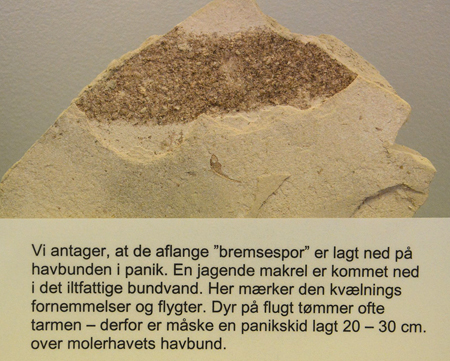 |
|
|
The cliff on the northern side of Fur clearly show the past changes in nature.
It is a wonderful day in septemer 2013. The sun is shining, no clouds and no wind. |
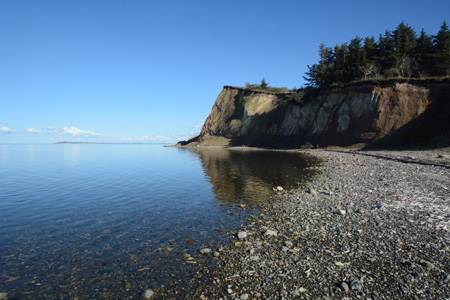 |
|
|
Here you see the cliff that has undergone great changes.
Turists and geologians come from all over the world to see this unique part of nature on the Island of Fur. |
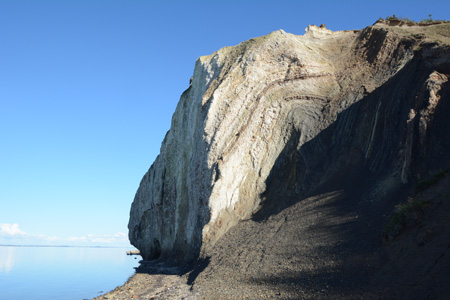 |
